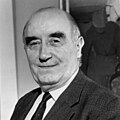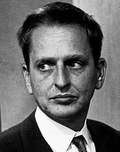|
| Portrait | Minister
(Born-Died) | Term | Political Party | Coalition | Cabinet |
|---|
| Took office | Left office | Duration |
|---|
| | | Albrecht Elof Ihre
(1797–1877) | 16 May 1840 | 29 December 1842 | 2 years, 227 days | Independent | – | Charles XIV John |
| | | Samuel Grubbe
(1786–1853)
Acting
[4] | 10 September 1840 | 29 December 1842 | 2 years, 110 days | Independent | – | Charles XIV John |
| | | Christopher Isac Heurlin
(1786–1860)
[5] | 29 December 1842 | 18 May 1844 | 1 year, 141 days | Independent | – | Charles XIV John |
| | | Fredrik Otto Silfverstolpe
(1795–1882) | 18 May 1844 | 10 April 1848 | 3 years, 328 days | Independent | – | Oscar I |
| | | Paulus Genberg
(1811–1875)
[6] | 10 April 1848 | 2 April 1852 | 3 years, 358 days | Independent | – | Oscar I |
| | | Henrik Reuterdahl
(1795–1870)
[7] | 3 April 1852 | 9 March 1855 | 2 years, 340 days | Independent | – | Oscar I |
| | | Lars Anton Anjou
(1803–1884)
[8] | 9 March 1855 | 29 January 1859 | 3 years, 326 days | Independent | – | Oscar I |
| | | Henning Hamilton
(1814–1886)
[9] | 29 January 1859 | 2 November 1860 | 1 year, 278 days | Independent | – | Oscar I |
| | | Carl Johan Thyselius
(1811–1891) | 2 November 1860 | 1 August 1863 | 2 years, 272 days | Independent | – | Oscar I |
| | | Fredrik Ferdinand Carlson
(1811–1887)
[10] | 1 August 1863 | 3 June 1870 | 6 years, 306 days | Independent | – | Oscar I |
| | | Gunnar Wennerberg
(1817–1901) | 3 June 1870 | 11 May 1875 | 4 years, 342 days | Independent | –
– | Charles XV
Oscar II |
| | | Fredrik Ferdinand Carlson
(1811–1887)
[10] | 11 May 1875 | 1 November 1878 | 3 years, 174 days | Independent | – | De Geer II
De Geer III |
| | | Carl Gustaf Malmström
(1822–1912)
[11] | 1 November 1878 | 27 August 1880 | 1 year, 300 days | Independent | – | Posse |
| | | Carl Hammarskjöld
(1838–1898)
[12] | 27 August 1880 | 6 February 1888 | 7 years, 163 days | Independent | – | Thyselius
Themptander |
| | | Gunnar Wennerberg
(1817–1901) | 6 February 1888 | 6 November 1891 | 3 years, 273 days | Moderate | –
–
Lantmanna–M | G. Bildt
Åkerhielm
Boström I |
| | | Gustaf Gilljam
(1832–1908)
[13] | 6 November 1891 | 22 June 1898 | 6 years, 228 days | Independent | Lantmanna–M | Boström I |
| | | Nils Claëson
(1848–1910)
[14] | 22 June 1898 | 5 July 1902 | 4 years, 13 days | Independent | M–Lantmanna | von Otter |
| | | Carl von Friesen
(1846–1905)
[15] | 5 July 1902 | 10 June 1905 | 2 years, 340 days | Independent | M–Lantmanna | Boström II
Ramstedt |
| | | Karl Husberg
(1854–1928)
[16] | 19 June 1905 | 2 August 1905 | 44 days | Independent | M–Lantmanna | Ramstedt |
| | | Hjalmar Hammarskjöld
(1862–1953)
[17] | 2 August 1905 | 7 November 1905 | 97 days | Independent | M–Lantmanna–L | Lundeberg |
| | | Fridtjuv Berg
(1851–1916)
[18] | 7 November 1905 | 29 May 1906 | 203 days | Liberals | – | Staaf I |
| | | Hugo Hammarskjöld
(1845–1937)
[19] | 29 May 1906 | 11 June 1909 | 3 years, 13 days | National Progress Party | M–Lantmanna–Första kammarens moderata parti–National Progress Party | Lindman I |
| | | Elof Lindström
(1863–1924)
[20] | 11 June 1909 | 7 October 1911 | 2 years, 118 days | Independent | M–Lantmanna–Första kammarens moderata parti–National Progress Party | Lindman I |
| | | Fridtjuv Berg
(1851–1916)
[18] | 7 October 1911 | 17 February 1914 | 2 years, 133 days | Liberals | – | Staaf II |
| | | Karl Gustaf Westman
(1876–1944) | 17 February 1914 | 30 March 1917 | 3 years, 41 days | National Party | – | Hammarskjöld |
| | | Alexis Hammarström
(1858–1936) | 30 March 1917 | 19 October 1917 | 203 days | Independent | Electoral League–National Party | Swartz |
| | | Värner Rydén
(1878–1930)
| 19 October 1917 | 28 November 1919 | 2 years, 40 days | Social Democrats | S/SAP–L | Edén |
| | | Olof Olsson
(1872–1939)
[22] | 28 November 1919 | 27 October 1920 | 334 days | Social Democrats | – | Branting I |
| | | Bengt J:son Bergqvist
(1860–1936)
[23] | 27 October 1920 | 13 October 1921 | 351 days | Independent | – | De Geer
von Sydow |
| | | Olof Olsson
(1872–1939)
[22] | 13 October 1921 | 19 April 1923 | 1 year, 188 days | Social Democrats | – | Branting II |
| | | Samuel Clason
(1867–1925) | 19 April 1923 | 18 October 1924 | 1 year, 182 days | Electoral League | – | Trygger |
| | | Olof Olsson
(1872–1939)
[22] | 18 October 1924 | 7 June 1926 | 1 year, 232 days | Social Democrats | – | Branting II |
| | | John Almkvist
(1875–1946) | 7 June 1926 | 2 October 1928 | 2 years, 117 days | Liberals | L–L | Ekman I |
| | | Claes Lindskog
(1870–1954)
[24] | 2 October 1928 | 7 June 1930 | 1 year, 248 days | Electoral League | – | Lindman II |
| | | Samuel Stadener
(1872–1937) | 7 June 1930 | 24 September 1932 | 2 years, 109 days | Liberals | – | Ekman II |
| | | Arthur Engberg
(1888–1944)
[25] | 24 September 1932 | 19 June 1936 | 3 years, 269 days | Social Democrats | – | Hansson I |
| | | Tor Andræ
(1885–1947) | 19 June 1936 | 28 September 1936 | 101 days | Independent | – | Pehrsson-Bramstorp |
| | | Arthur Engberg
(1888–1944)
[25] | 28 September 1936 | 13 December 1939 | 3 years, 76 days | Social Democrats | S/SAP–C | Hansson II |
| | | Gösta Bagge
(1882–1951) | 13 December 1939 | 15 December 1944 | 5 years, 2 days | Moderate | S/SAP–C–M | Hansson III |
| | | Georg Andrén
(1890–1969) | 15 December 1944 | 31 July 1945 | 228 days | Moderate | S/SAP–C–M | Hansson III |
| | | Tage Erlander
(1901–1985) | 31 July 1945 | 11 October 1946 | 1 year, 72 days | Social Democrats | – | Hansson IV |
| | | Josef Weijne
(1893–1951) | 11 October 1946 | 8 March 1951 | 4 years, 148 days | Social Democrats | – | Erlander I |
| | | Hildur Nygren
(1896–1962)
[26] | 17 March 1951 | 1 October 1951 | 198 days | Social Democrats | – | Erlander I |
| | | Ivar Persson
(1901–1979)
[27] | 1 October 1951 | 30 October 1957 | 6 years, 29 days | Centre | S/SAP–C | Erlander II |
| | | Ragnar Edenman
(1914–1998) | 31 October 1957 | 29 September 1967 | 9 years, 333 days | Social Democrats | – | Erlander III |
| | | Olof Palme
(1927–1968)
[28] | 29 September 1967 | 31 December 1967 | 93 days | Social Democrats | – | Erlander III |








































